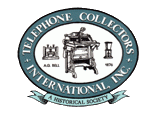
Telephone Collectors International
Tickled by Nickel
Last update May 14, 2015
 | Telephone Collectors InternationalTickled by Nickel | First Posted Mar 11, 2001 Last update May 14, 2015 |
From the December 1998 Singing Wires Journal newsletter
by Steve Brink

I had obsessed for a couple of years on possessing a Stromberg-Carlson "oilcan". I would have settled for any of the versions but really wanted the earlier one with cast base and small transmitter. About two weeks before this year's Abilene show I received a call from a collector who was answering my newsletter want ad. He said he had an "oilcan" and would save it for me at his table in Abilene until I had a chance to look at it. I was very excited to find it to be the early version I had wanted but it did need lots of TLC (see before photo). I know that original nickel is best but when a phone is this far gone, a "makeover" is in order. It had very little nickel left and lots of brass corrosion. Since I am an artist by profession and pretty meticulous, I wouldn't trust just anyone to renickel it. I wanted to preserve all details like the knurled parts on the bolts, so I decided to take on the job myself. What follows are the steps I used to restore the phone. Bye the way, although this oilcan isn't my most valuable phone, it is my favorite.

These Dremal tools are great for other stuff too.
Nickeling: To restore that stick nearly devoid of nickel, use an inexpensive Texas Platers Nickel Kit.
This is available from Texas Platers Supply, 2453 W. Five Mile Parkway, SGN., Dallas, Texas 75233. Phone (214) 330-7168
The piece needs to be super shiny to get a shiny nickel job. It also needs to be clean! Wash the piece in a non-lotion soap and hot water. This works for me. They suggest using a solvent to make sure no oil is on the surface. I have used alcohol (an adult beverage on the table might be a good idea too). Read all instructions and safety items from the nickel plating kit. Hook up the D.C. voltage per instructions in the kit. Take the brush and brush on the solution. Try not to nick the piece with the metal part of the brush. It works great and is easier than painting. Wash the nickel paste off in the sink and admire your work. If it isn't as nice as you expected, you can remove the nickel with 600 grit and rebuff and try again.
Good Luck,
Steve